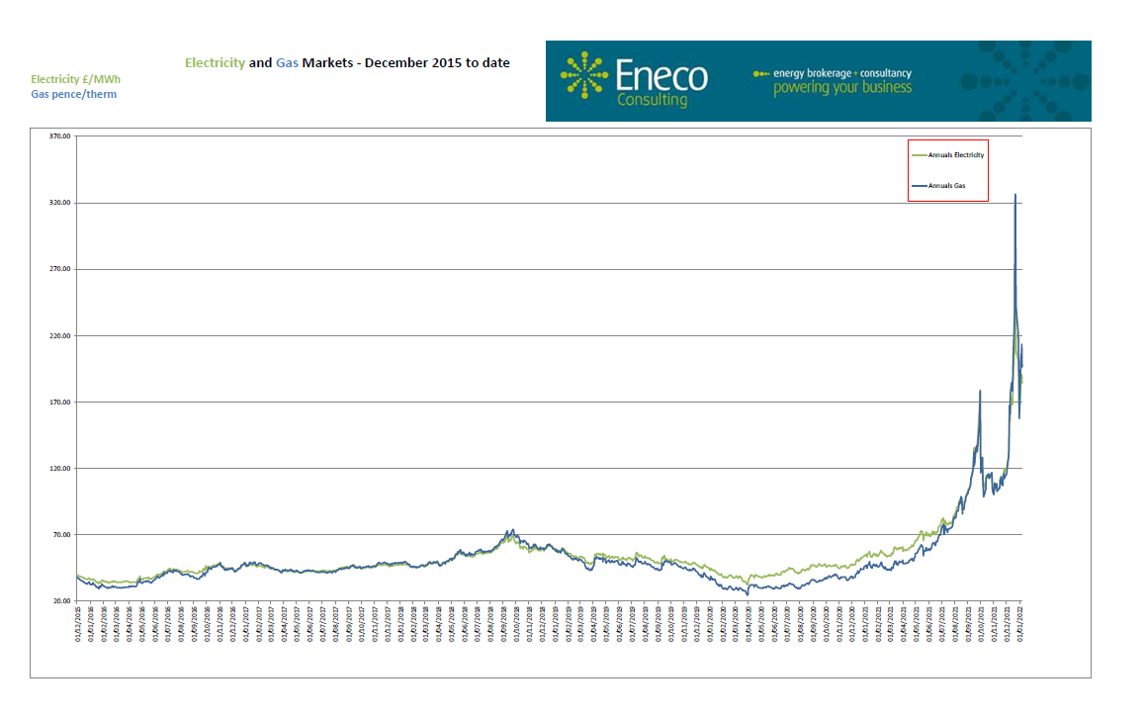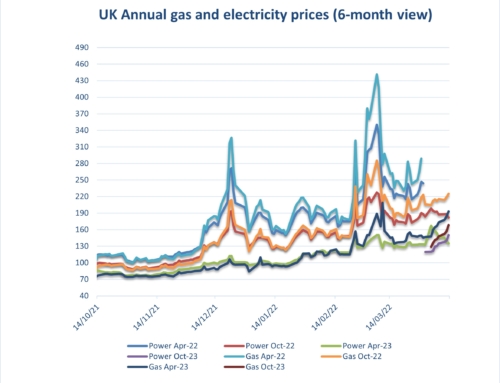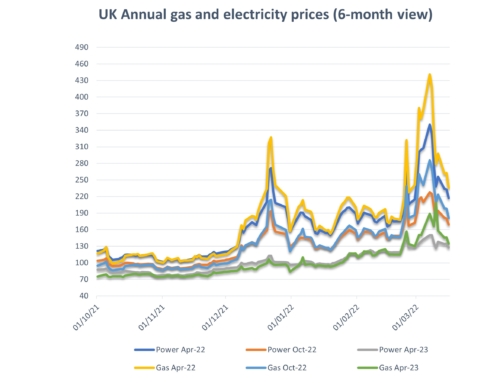Eneco market reports early January 2022
Energy costs:
It has been an unprecedentedly volatile three weeks on the UK power and gas markets, with the price swings even dwarfing the record levels we saw across the last few months of 2021. Having rocketed massively above any previous highs just before Christmas, prices then plummeted lower – with January UK power ending last year more than 60% down from its peak and April ’22 Annual down by more than 40%. However prices then rebounded as 2022 started…before curling lower again over the last few days. Changing weather forecasts, Russian gas supply sentiment and French nuclear power expectations have been the main market drivers.
Milder and windier weather forecasts and increasing LNG diversions to Europe helped puncture the supply panic in the last week of December, as did receding fears over future Russian gas supply – amid comments from Vladimir Putin that more gas was ready to flow and hopes that January talks between Russia and the West might defuse Ukraine-related tensions. But as weather forecasts turned colder again and physical Russian gas flows actually dropped in the new year, prices bounced higher.
January UK power ended 2021 at £210/MWh, down from a traded high of £575/MWh just a week before. February, which tripped to even high levels, at the same time fell back to £285/MWh, a significant premium to January – bolstered by ongoing French nuclear supply fears for the month (French February power reached over EUR 1000/MWh).
Prices across next summer and winter also slid back to mid-December levels, but have since kicked higher again. April ’22 Annual in turn fell to a low of £158/MWh, after spiking to an all-time high of £271/MWh on December 22nd. Having touched £190/MWh again last week, it is currently discussed around £182/MWh. April ’23 Annual meanwhile has been oscillating either side of £100/MWh.
EUA carbon emissions, after dipping in the run-up to Christmas, have since rallied – to above EUR 88/TCO2 last week, a drop in state auction volumes contributing. UKAs however have been less bullish, struggling to push above £75/TCO2 since Christmas.
Year-ahead coal prices, having tumbled to a five-and-a-half month low, of $90/tonne at the end of last year, have since rebounded, helped by Indonesia banning exports to satisfy domestic generation demand.
A big swing to the downside was also seen on short-term power prices towards the end of last year, with Day-ahead – which surged above £400/MWh in mid-December – slumping below £115/MWh on December 30th (its lowest level since August) amid high renewables output (wind meeting 42% of national daily generation) and reduced demand as warmer than normal weather swept across the UK. Prices have since rebounded to £225/MWh as the weather has turned colder and calmer.
In mainland Europe similar wild price swings have been seen across all periods, while for the first time since 2010 German short-term prices did not go negative over Christmas.
Outlook:
- “Historically low” nuclear availability in France for the time of year, has increased the risk of a power shortage there this month, particularly if there is a cold spell, according to French network operator RTE.
- Used Audi car batteries are to be aggregated into a 4.5 MWh pilot battery project in Germany by RWE, to help manage power network frequency. The batteries, from electric Audi cars, could still have an operating life of up to ten years, the companies say.
- A further sell-off is possible, with Month-ahead prices still more than 30% higher than where they were two months ago and nearly three-and-a-half times what they were at this time last year, while the front Annual is still 75% higher than two months ago and also more than three times higher than a year ago.
Gas Costs:
UK gas prices have soared, plunged, rebounded and then started to edge lower again over the last three weeks, with Month-ahead witnessing an astonishing 210-452 p/th price range and Annual-ahead seeing its price tags swing wildly between 157-332 p/th.
Comments from President Putin that approval of the Russia-Germany Nord Stream 2 pipeline will lead to more Russian gas exports to Europe – “large volumes, additional volumes…immediately” – just as Gazprom confirmed it had filled Nord Stream 2’s second pipe ready to begin transportation, contributed to the sell-off in the last week of December, as did the scheduling of talks between Russia and the West to defuse Ukraine border tensions. Milder weather forecasts – with temperatures up to 10 degrees above normal in many parts of Europe, a ramp-up in wind power output and a surge in expected LNG deliveries as Asian prices eased, also piled on the bearish pressure.
As the new year started and weather forecasts changed, physical Russian flows into Europe dropped and unscheduled production issues were reported at Norway’s Osberg field, prices rebounded strongly.
April ’22 Annual reached a new record value of 332 p/th on December 22nd, the highest ever level (by a significant margin) for any annual, having rocketed an unheard of 50% in value in a single day the day before, as Russian flows through one key route into Europe halted completely. Prices then halved over the next week, on profit-taking as well as the improved supply outlook. They briefly tripped above 200 p/th last week, but have been edging lower since.
Less volatility has been seen further forward, with April ‘23 Annual, for example, oscillating between 84-110 p/th, and hovering around 97 p/th at the time of writing.
Unrest in Kazakhstan, an OPEC producer, has meanwhile helped shore up oil prices, pushing North Sea oil up to $82/barrel over the last couple of days, its highest value since November.
Month-ahead gas was nudging higher at the time of writing, moving above 220 p/th, although this is still 15 p/th off prices seen last week, and in line with mid-November levels.
Day-ahead UK gas meanwhile was also inching higher today, trading at 215 p/th, up from the recent low of 172 p/th it reached at the end of last year but well down from the record high of over 457 p/th it hit just before Christmas.
European gas storage volumes have dropped to 56% fullness overall, compared to 70% fullness at this time last year, according to Gas Storage Europe, the storage operators’ association.
Outlook:
- While European storage capacity is still above 50% full half-way through the gas winter, traditionally the coldest part of winter is still to come. Stocks could deplete rapidly if there is an extended cold spell and/or renewables output stays low.
- The outcome of talks between the US and Russia this week in Geneva could swing the market either way – with a resolution or agreement likely to weigh on prices by improving the Russian gas outlook, and any breakdown in talks potentially ratcheting supply concerns and prices higher.
- US LNG exports to Europe rose 20% last year. Further increases are possible this year as new capacity means the US is likely to become the world’s biggest LNG exporter, overtaking Australia and Qatar, although Asian appetite and prices are likely to again have a major influence on how much LNG reaches Europe.
Non-energy costs:
On the electricity side organisations will see further increases in pass through costs from both government and industry infrastructure providers from 2022 onwards due to pandemic-related demand destruction. Levies normally collected via unit rates have fallen short of expectations and have fed through to further increases in ROs, FiTs, EII and other transportation, distribution and renewable investment charges. In addition to this the Targeted Charging Review (TCR) is coming into effect from April 2022 and is being priced into renewal contracts now. Projections are available on our website via the links below.
What is the Targeted Charging Review (TCR) electricity –
TCR is a change to both Distribution Use of System (DUoS) and Transmission Network Use of System (TNUoS) charges you will find within a supply contract.
DUoS: changes in effect from 01/04/2022 (delayed from 2021)
- Paid to the associated distributor (DNO), the cost covers installation and maintenance of local distribution networks.
- At present, a DUoS charge is based on the volume of electricity consumed at site, which has passed through the distribution network.
TNUoS: changes in effect from 01/04/2023 (delayed from 2022)
- Paid to National Grid, the cost recovers the cost of installing and maintaining transmissions systems.
- At present, the charge is based on a meter’s share of demand on the network during 3 peak periods, known as Triads. These 3 Triad periods occur between 1st Nov to 28th Feb each year. It’s assessed during this time as demand on the grid is at its highest.
Why the change? A lot of businesses have Triad avoidance techniques in place. During November to February, the 3 largest consuming days will affect a TNUoS charge for a whole year, therefore it pays to be savvy in cutting down consumption on days which would otherwise have been large consuming. Ofgem want to eradicate an unfair grid, therefore both DUoS and TNUoS charges will be veering away from a consumption-based charge to a daily-based charge, determined by voltage type (where you connect to the network), measurement class (Half-Hourly/Non-Half-Hourly), and maximum agreed capacity.
It’s a complex change and difficult to assess the impact on individual meters as suppliers are allocating charges differently. although many are wrapping TCR into increased standing charges. However, to summarise, meters with high capacity but lower usage will be worst affected. For example, a sports stadium will have a high agreed capacity to account for large peaks on event/match days, yet for the most part will have a relatively small usage compared to this capacity. If you want to discuss this further, please call into the office to speak with Abby.
Is your organisation covered by the new Streamlined Energy and Carbon Reporting (SECR) scheme from the Environment Agency?
Designed to replace in part the Carbon Reduction Commitment (CRC) which ended in 2019 and to follow on from the energy savings recommendations generated by ESOS compliance. Note, SECR will cover a wider scope of organisations than CRC and ESOS do. SECR requires all large enterprises to disclose within their annual financial filing obligations to Companies House, their greenhouse gas emissions, energy usage (from gas, electricity and transportation as a minimum), energy efficiency actions and progress against at least one intensity ratio.
If your organisation qualifies, participation in this scheme is mandatory. Eneco Consulting are happy to provide assistance with your regulatory obligations. Full details are available on our website on the link below.
Are you eligible for an EII rebate?
Under current rules, if you qualify at an industry sector level and your business passes the 20% electricity intensity test you may qualify for exemption to CFD and RO charges. Please see the attached Government RO/CFD guidance document and update and give Abby a call on the main number to discuss this further.
Gas and electricity prices from 2009 to date
A copy of our environmental charges and Climate Change Levy rates from 2012 to date: Industry and Environmental Pass Through Charges including CCL p/kWh Updated 31082021
A copy of RO/CFD guidance document: RO_CFD_Guidance_Revised_July_2018
SECR: SECR EA Guidelines
TCR Charges (Targeted Charging Review this will be revised in November 2021 when Ofgem releases its review): TCR Charges (Targeted Charging Review) TNUOS bandings and Current Ofgem Costs now for 2023 onwards




